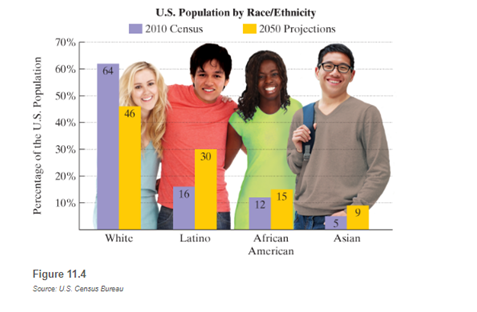
Concept explainers
The graph in Figure
shows the percentage of the U.S. population by race/ethnicity for

The data in Figure
shows that in
Write a formula for the
th term of the arithmetic sequence that describe the percentage of the U.S. population that will be Latino
years after 2009.
What percentage of the U.S. population is projected to be Latino in 2030?
Want to see the full answer?
Check out a sample textbook solution
Chapter 11 Solutions
Intermediate Algebra for College Students (7th Edition)
Additional Math Textbook Solutions
Elementary & Intermediate Algebra
Introductory Statistics
Probability And Statistical Inference (10th Edition)
Calculus for Business, Economics, Life Sciences, and Social Sciences (14th Edition)
College Algebra (Collegiate Math)
Precalculus: A Unit Circle Approach (3rd Edition)
- Please Help me answer this linear algebra question. This is a practice textbook question.arrow_forwardTY D om E h om ng 00 C B A G F Q ו 3 13 Details Find an Euler path for the graph. Enter your response as a sequence of vertices in the order they are visited, for example, ABCDEA. fic ► Question Help: Video Message instructor Submit Question tor arch 園 A Wind advisoryarrow_forwardYou are provided with three 2D data points, p1, p2 and p3. Solving A C = B for C provides youwith the coefficients of a natural cubic spline curve that interpolates these points.Additionally, you have been given A and B, but some elements are missing. Moreover, the last two rowsof A are entirely absent. Your task is to determine and fill in the missing elements. For the last two rows,enforce a zero tangent at the beginning (in p1) and a not-a-knot boundary condition in p2. The matricesA and B are given as follows:Explain how to find the entries of A and B . How would you adapt these matrices if the data pointswere 3D? What if your spline should go through five data points? How many “extra rows” would there thenbe (with “extra” meaning “in addition to securing C2-continuity”)?arrow_forward
- Which graph represents f(x) = √x-2+3?arrow_forwardPractice Assignment 5.6 Rational Functions M Practice Assig Practice Assignment 5.6 Rational Functions Score: 120/150 Answered: 12/15 Question 10 A Write an equation for the function graphed below 5 + 4 1 2 H + + -7 -6 -5 -4 -3 -2 -1 2 34567 | -2 ర y = Question Help: Video Message instructor Post to forum Submit Questionarrow_forwardit's not algebra 4th gradearrow_forward
- x/x-2 + 3/x-4arrow_forwardQ1: A: Let M and N be two subspace of finite dimension linear space X, show that if M = N then dim M = dim N but the converse need not to be true. B: Let A and B two balanced subsets of a linear space X, show that whether An B and AUB are balanced sets or nor verly A:LeLM be a subset of a linear space X, show that M is a hyperplane of X iff there exists fe X'/[0] and a EF such that M = {x Ex/f(x) = = a}. B:Show that every two norms on finite dimension linear space are equivalent C: Let f be a linear function from a normed space X in to a normed space Y, show that continuous at x, EX iff for any sequence (x) in X converge to x, then the sequence (f(x)) converge to (f(x)) in Y.arrow_forward2/26 Delta Math | Schoology X Unit 4: Importance of Education X Speech at the United Nations b x Book Thief Part 7 Summaries x + > CA Materials pdsd.schoology.com/external_tool/3157780380/launch ☆ MC Updates Grades Members BrainPOP Canva for Education DeltaMath Discovery Education FactCite Gale In Context: High Sc. Graw McGraw Hill K-12 SSO Draw a line representing the "rise" and a line representing the "run" of the line. State the slope of the line in simplest form. Click twice to plot each segment. Click a segment to delete it. 10 9 8 5 сл y Hill Nearpod 3 2 Newsela -10 -9 -8 -7 b -5 -4-3-2 -1 1 23 4 5 b 7 89 10 Scholastic Digital Mana. World Book Online Information Grading periods MP3: 2025-01-25-2025-03- 31, MP4: 2025-04-01-2025- 06-13 ← 2 M -> C % 95 54 # m e 4 7 巴 DELL A t y & * ) 7 8 9 . i L Feb 27 12:19 US + 11arrow_forward
 Trigonometry (MindTap Course List)TrigonometryISBN:9781337278461Author:Ron LarsonPublisher:Cengage Learning
Trigonometry (MindTap Course List)TrigonometryISBN:9781337278461Author:Ron LarsonPublisher:Cengage Learning
 Glencoe Algebra 1, Student Edition, 9780079039897...AlgebraISBN:9780079039897Author:CarterPublisher:McGraw Hill
Glencoe Algebra 1, Student Edition, 9780079039897...AlgebraISBN:9780079039897Author:CarterPublisher:McGraw Hill

 Big Ideas Math A Bridge To Success Algebra 1: Stu...AlgebraISBN:9781680331141Author:HOUGHTON MIFFLIN HARCOURTPublisher:Houghton Mifflin Harcourt
Big Ideas Math A Bridge To Success Algebra 1: Stu...AlgebraISBN:9781680331141Author:HOUGHTON MIFFLIN HARCOURTPublisher:Houghton Mifflin Harcourt





